
A Michigan local spotted a rare natural phenomenon occurring the state's Pine River last week, and it's so eerily perfect, it looks like someone snuck out onto the wintery lake and carved it up with an ice cutter.
In reality, this round disc of ice, which reportedly spun in a slow, clockwise direction for several hours last Friday, is a really nice example of a peculiar formation that occasionally appears on top of a frozen lake as it melts.
The footage was shot by Michigan resident Jason Robinson from the Schmied Road bridge over the Pine River in the town of Vestaburg.
"I've seen some pretty cool stuff in the woods - things you don't expect to see," he told MLive.com.
Amazingly, even though you can see some really cool footage of other 'melting ice discs' on YouTube, scientists have only very recently been able to wrap their heads around what's actually going on here.
For over a century, researchers have been investigating the physics underlying the phenomenon, and over the decades, it became clear that there was nothing simple about this cool circle of ice.
The most common explanation for the spinning ice discs is that, as cold, dense air comes in contact with an eddy in a river - a circular movement of water that forms a small, natural whirlpool - it forms a perpetually spinning circle.
But this could only be part of the story, because melting ice discs can be anywhere from 1 to 200 metres across, and the laws of physics would cause them to behave differently, depending on the size.
As Brendan Cole explained for us last year:
"If eddies were the only culprit, small discs would spin faster than big discs, and this isn't at all what people see: discs across that huge range of sizes rotate at pretty much the same rate. Even worse for the prevailing wisdom, you'd expect that discs in still water, where there aren't any eddies, wouldn't start spinning, but they do."
So a team led by Stéphane Dorbolo from the University of Liége in Belgium decided to get to the bottom of these crazy things once and for all.
Using some cameras, a nickel bead, a magnet, and Petri dish popsicles, the researchers simulated what happens when a sheet of ice floating on water starts to melt, as it would on a frozen river as the weather warms up.
Strangely enough, the ice sheet started rotating, even though the team hadn't added any eddies to the model.
Turns out, the spinning is actually down to some crazy properties in the water itself - not the currents it forms in a flowing river.
As Ryan F. Mandelbaum explains for Gizmodo, water happens to be at its densest at exactly 39.2 degrees Fahrenheit (4 degrees Celsius) - and that's important.
"In their experiments, the scientists measured the flow of the water beneath the ice, and found that the icy disc cooled the water surrounding it," says Mandelbaum.
"When surrounding water hit the 39.2 degrees point, it sank and formed a vortex. This vortex of water whirls the ice floating atop it."
But while the paper, published in Physical Review E last April, finally explains the spinning, it doesn't explain how the disc ends up in such a perfectly round shape.
It could be that shards of ice are collected up by the vortex and added to the disc to form the circle shape, or maybe the circle shape develops gradually - the disc smoothes itself out over hundreds and thousands of rotations.
But hey, we don't mind a bit of mystery when it comes to nature (but seriously, someone needs to investigate this).
Here's another one for the road:

H/T: Gizmodo
